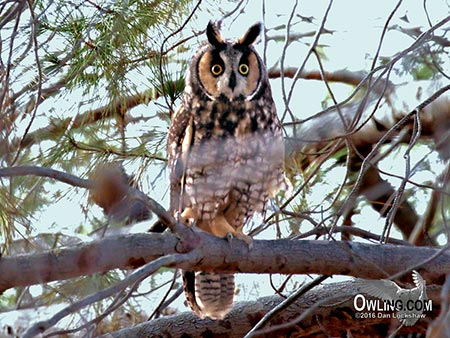
Long-eared Owl
A Reference for North and Central American Owls
The Long-eared Owl is found around the world in the Northern Hemisphere. In North America it is similar in color to the Great Horned Owl but is smaller, thinner and its chest bars have vertical cross streaks. In flight it is similar in appearance to the Short-eared Owl. It can be separated from from this species by its darker underside color, orange face, and underside cross baring as oppose to the vertical underside streaking of the Short-eared Owl. Winter roosts can have up to 70 birds and are generally used year after year. Here you will find photos, recordings and a discussion in its field notes section to help find, identify, and enjoy this beautiful owl.
A more in depth write up can be found on its natural history page.
To jump immediately to any of these sections use the Page Tabs below.
Advertisement (male) song.
There are no videos at this time. Please check back with us.
FIELD NOTES
Long-eared owl – Asio otus
In flight, the Long-eared Owl is very similar to the Short-eared Owl, as the ear tufts are almost invisible. The Long-eared is generally darker overall, though, and has cross barring along the sides and chest as opposed to the Short-eared Owl’s streaking; the facial disk is also rusty rather than whitish. its markings are similar to the Great Horned Owl although its longer more closely separated ear tufts, smaller size and slender shape set it apart. The sexes are alike although the males tend to be paler.
Long-eared Owls are nocturnal owls that roost in dense foliage near tree trunks in the daylight hours. Length is 15″ (about the size of a Cooper’s Hawk), similar in size to both the Barn and Short-eared Owls. Winter roosts consist of 7-50 birds and are often used year after year by similar number of owls. When disturbed at a roost, the Long-eared Owl will adopt a sleek upright posture with ear tufts fully erect.
